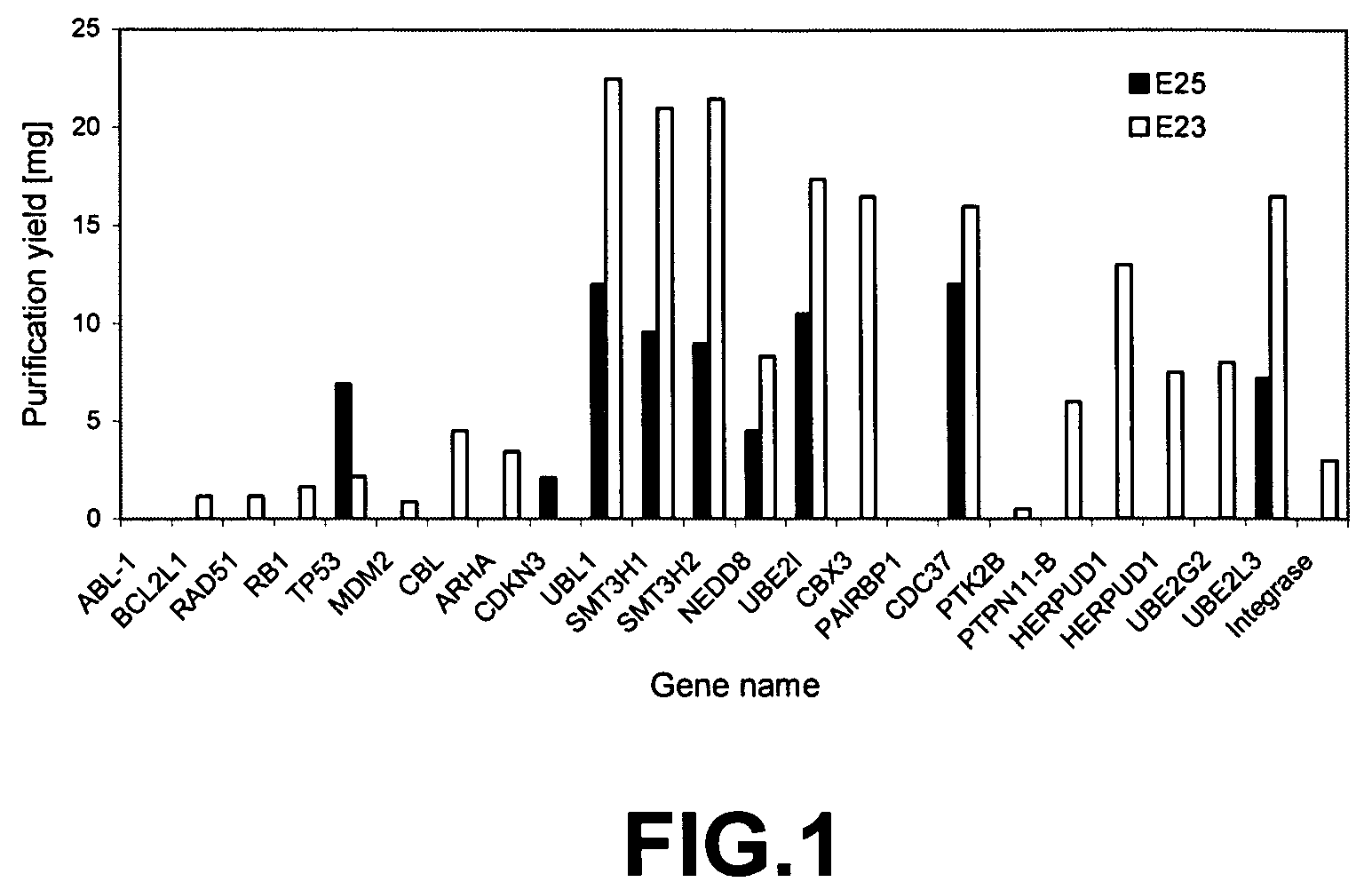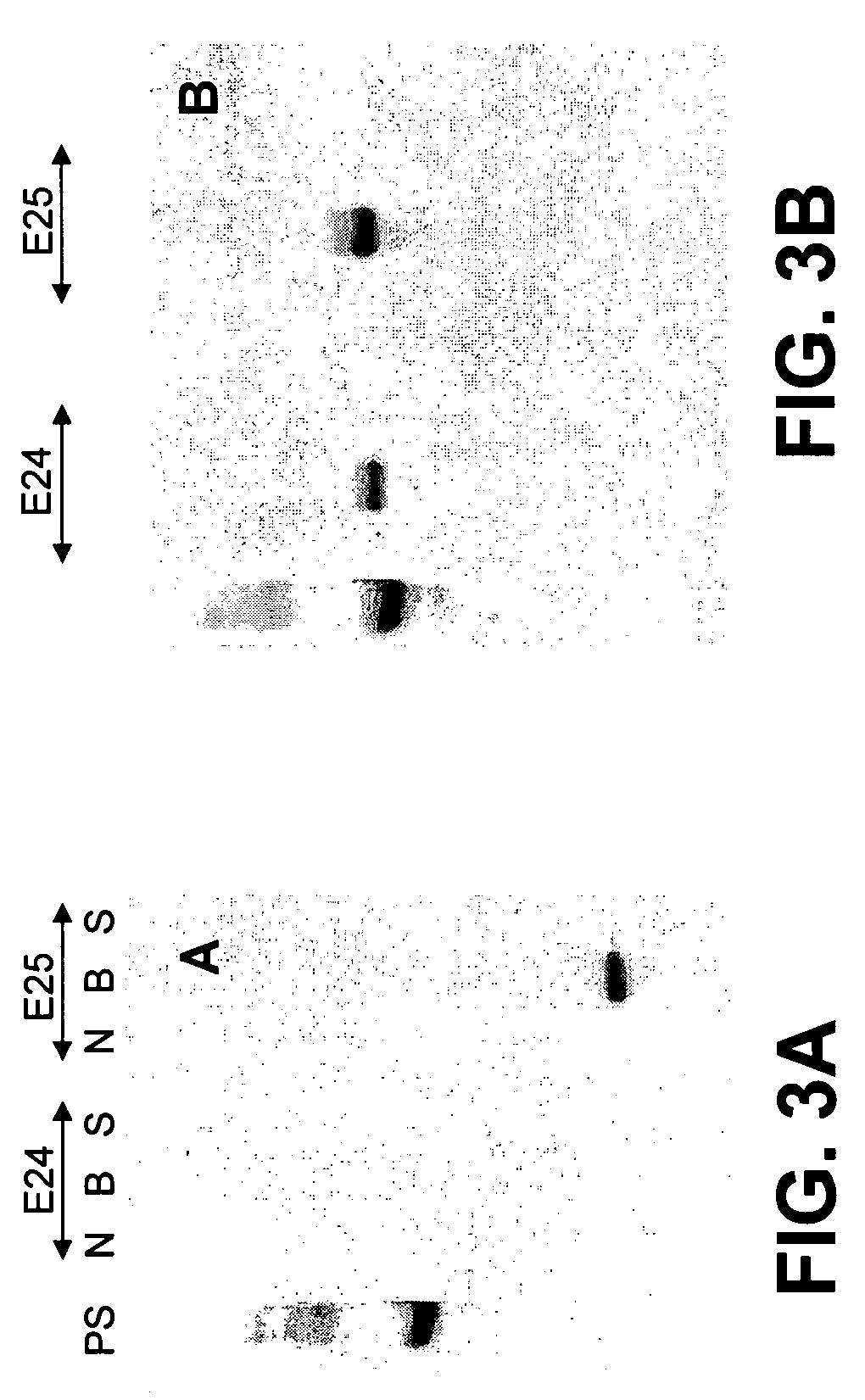Method for purification of a protein complex and identification of its components
a protein complex and protein technology, applied in the field of protein complex purification, can solve the problem of large excess of bait proteins, and achieve the effects of high throughput format, high affinity, and specificity and ease of elution
- Summary
- Abstract
- Description
- Claims
- Application Information
AI Technical Summary
Benefits of technology
Problems solved by technology
Method used
Image
Examples
example 1
Construction of Expression Vectors
[0085]The E. coli expression vectors E23, E24 and E25 are based on the Invitrogen Gateway compatible vector pDEST15 (Cat# 11802-014) in which transcription is driven by the T7 promoter and which contain the sequence encoding Glutathione-S-Transferase (GST) at the N-terminus. PCR products amplified from M07 (see Example 11) were inserted into vector E04 which is a modified version of pDEST15 (expression vector which encodes a GST fusion domain, Invitrogen, Carlsbad, Calif.) containing a tag for GST and CBP (calmodulin binding peptide) separated by a cleavage site for PRESCISSION™ protease. E04 was made using the following PCR primers, GGAACCGGTGAAGGAGATAGAACCATGTCCCCTATACTAGGTTATTG-PinAI-SD-GST-F (SEQ ID NO: 16); TCCCTCGAGCCTGGTACCGAAAGTGCCCCGG-XhoI-CBP-R (SEQ ID NO: 17), to amplify pGEX4T3 / TAP (Amersham Biosciences, Piscataway, N.J.). Vector pGEX4T3 / TAP and the PCR product were both digested with PinA1 and Xho I and ligated together.
[0086]Bacterial ...
example 2
Expression and Purification of Bacterially Expressed Proteins
[0096]The E23, E24, and E25 constructs containing tag only (control with no bait protein) or various bait proteins such as Grb2, NAPA, CDKNb1 were expressed in E. coli. see FIGS. 1 and 2 for additional bait proteins.
[0097]In order to express the bait proteins, two ml of LB medium containing 100 μg / ml Ampicillin was inoculated with a single colony containing the desired expression vector and the culture was incubated at 37° C. in a shaker incubator. After 8 hours, one ml of the culture was diluted into 25 ml of fresh LB medium (100 μg / ml Ampicillin) and incubated overnight at 37° C. The overnight culture was diluted into 1 liter of LB medium containing 100 μg / ml of Ampicillin and an antifoam agent, in a Nalgene centrifuge bottle, to a final OD595 of 0.05. The bottle was left immersed in a water bath (Bactolift apparatus) at 30° C. with an airflow of 10 cc / min into the culture bottle. When the culture reached an optical dens...
example 3
Purification of Expressed Proteins on a Ni2+ Column
[0098]In order to purify the expressed proteins in E23-, E24-, and E25-tagged vectors, a 24-well Whatman deep well plate (UNI-FILTER, 24 wells, 10 ml, Polypropylene, Whatman GFC, MBPP 25-30, VWR International, West Chester, Pa.) was placed on top of the Whatman vacuum manifold system, and each well was loaded with 2 ml of Ni-NTA resin (Invitrogen Corp.) and pre-equilibrated with binding buffer (50 mM Na2HPO4, 500 mM NaCl, 10 mM Imidazole, pH 8.0). Ten ml of the supernant (cell extract) was added to each well and a vacuum was applied slowly to filter away the cell extract without disrupting the binding of the tagged fusion protein to nickel. An additional 10 ml of the binding buffer was added to each well and then eluted under vacuum. After two more rounds of washing with the binding buffer, in the same manner, the fusion proteins were eluted with 5 ml of elution buffer (50 mM Na2HPO4, 500 mM NaCl, 400 mM Imidazole, pH7.4). The elute...
PUM
| Property | Measurement | Unit |
|---|---|---|
| volume | aaaaa | aaaaa |
| pH | aaaaa | aaaaa |
| pH | aaaaa | aaaaa |
Abstract
Description
Claims
Application Information
 Login to View More
Login to View More - R&D
- Intellectual Property
- Life Sciences
- Materials
- Tech Scout
- Unparalleled Data Quality
- Higher Quality Content
- 60% Fewer Hallucinations
Browse by: Latest US Patents, China's latest patents, Technical Efficacy Thesaurus, Application Domain, Technology Topic, Popular Technical Reports.
© 2025 PatSnap. All rights reserved.Legal|Privacy policy|Modern Slavery Act Transparency Statement|Sitemap|About US| Contact US: help@patsnap.com



